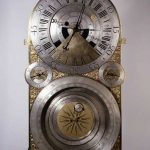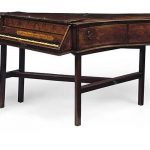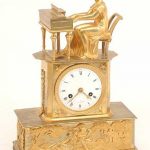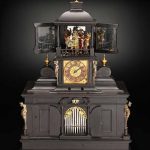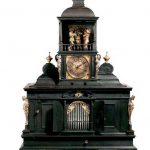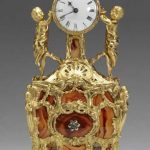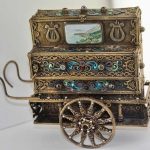A spinet is a smaller type of harpsichord or other keyboard instrument, such as a piano or organ. Miniature spinets could be used in music boxes and musical clocks.
Below are some examples of music boxes and clocks with spinets and a full size spinet.
Microcosm, or the world in miniature. Large astronomical clock with multiple dials, originally housed in a very large case with music and automata (now missing). Dial: Arched dial with repoussé foliage spandrel. Two large silvered-metal astronomical dials, upper with twenty-four hour ring, centre seconds, based on the Ptolemaic system; lower with Copernican system having four subsidiary dials showing: (top left) date, day and month, (top right) age of moon, new moon and full moon, (bottom left) dominical letter and year in the solar cycle, and (bottom right) the epact and golden number (ie number of the year in the lunar cycle).Movement: ‘Ting-tang’ quarter-strike. Compensated pendulum.Case: Mahogany case (later date than movement) with plain panels and moulded bridges; domed hood surmounted by five metal-gilt spherical and obelisk finials. TRAIN-COUNTS. Upper section of movement carries hour and quarter trains:- Hours. Gt wheel 80 2nd wheel 80/10 3rd wheel 64/8 4th wheel 56/8 Fly 8 Quarters. Gt wheel 80 2nd wheel 84/8 3rd wheel 64/7 4th wheel 56/8 Fly 8
Reference: © The Trustees of the British Museum
A GEORGE III MAHOGANY-CASED SPINET BY LONGMAN AND BRODERIP, CIRCA 1776 33 in. (84 cm.) high; 75 in. (190.5 cm.) wide Together with a George III mahogany revolving piano stool (2)
Sold for GBP 16,250 at Christie’s in 2009
CLOCK. Unusual French Empire period musical clock, consisting of a dore bronze case topped by a figure of a woman in Empire dress seated at a spinet, (possibly Jane Austin), the clock’s music box plays Mozart, the enameled dial inscribed “a Paris”, the pendulum mechanism chimes and the plinth is decorated with a musical couple in the country, good condition, 9 1/2″ w x 4 3/4″ d x 14″ h.
Sold for $2,400 at San Rafael Auction Gallery in 2008
Musical Clock with Musical Clock and Organ,ca. 1625 Veit Langenbucher German
Inside the ebony case of this musical clock is an extremely rare and important instrument consisting of a sixteen-note pipe organ and a sixteen-string spinet that may be played independently of the organ. Made by the renowned team of Samuel Bidermann and his son (also Samuel)–the father’s L-shaped pinning style appears in this work–and Viet Langenbucher, the extraordinary piece includes, in addition to the organ and spinet, a clock and five carved and colorfully clad commedia dell’arte figures that perform a circling dance in the clock’s tower when the instruments sound to mark the hours.
The complex clock is perhaps the most musically elaborate automatic instrument to survive from the early seventeenth century. Its three airs, probably by composer Hans Leo Hassler (baptized 1564-1612), the elder Bidermann’s teacher and once keeper of the knowledge of pinning barrels in Augsburg, are stored on the original pinned cylinder. Most cylinders and their tunes were replaced by subsequent generations, but this one was spared to provide us with an extremely rare musical document that allows us to hear the airs as they were played in the seventeenth century.
Reference: The Metropolitan Museum of Art
A EBONY ORGAN AND SPINET MUSICAL TABLE CLOCK WITH AUTOMATON FIGURES, AUGSBURG, GERMAN, EA
Sold for 312,000 USD at Sotheby’s in 2002
